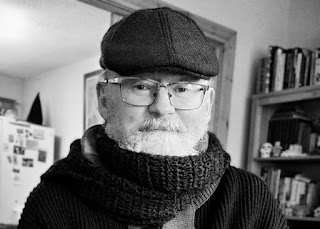Anthony McIntyre ✒ There had been gatherings of the same type in Drogheda before. Two years ago this month, Droghedians assembled in West Street to protest the brutal slaying of a local teen, Keane Mulready-Woods.
 |
| Ashling Murphy |
That so many of this week's vigils took place on popular river walks captured the symbolism of the circumstances pertaining to the death of the young victim. The location for the Drogheda vigil was a spot known as the Ramparts, situated between the River Boyne and a children’s playground. Often the source of gaiety and laughter, a sombre quietude had descended on the vicinity on Friday, like a fog: our candles in some small way emblematic of the community's determination to overcome the fading of the light. What children were there looked on in subdued silence, their thoughts not shared. They may have been there as pupils. I went along as a citizen but also as a trade union member. I felt it important to acknowledge the role of the murdered woman in society. Out of work a mere hour, and her life was snatched from her.
I walk the same Boyne River path where we had converged frequently with my dog. On the way I often come across lone women, walking, running and cycling. There are bushy recesses en route that could easily conceal a predator. Something I have long paid no attention to but which now makes me shudder. My daughter walked it frequently, sometimes alone. She has also walked the bank of the canal in Dublin close to where she attends university. I know it well, having made use of it myself on numerous occasions. As with the Boyne walk, I have met many women along the way. It being somewhat removed from the beaten track I have felt - unlike the Boyne walk - not so much the presence of menace but the potential for it.
Three years younger than Ashling Murphy, I have often told my daughter never to walk along the canal at night in Dublin, where she studies, no matter how much it might shorten her journey. I urge her to stick to main roads and well-lit streets. The Offaly killing makes me think just how limited that advice is: predators will prey night or day.
This morning, my daughter, now in Austria, sent me photos of her enjoying a skiing holiday. I thought of the things that Ashling Murphy has been denied, the keepsake images that a parent will never receive.
The death of Ashling Murphy has evoked memories of the recent murder in London of Sarah Everard, kidnapped and killed by a police predator serving with the Met. It too brought huge numbers of women onto the streets, only for some to be battered off them by the same force to which her killer belonged.
Garda Commissioner Drew Harris seeks to assure women that Ireland is still a safe society for them. It probably is relatively speaking. But predators still lurk in the shadows, just as they did fifty years ago. Only the other night I watched a documentary about the 1971 murder of Una Lynskey. Her killer was never caught. Then An Garda set about arresting innocent people. They did that on this occasion too. Fortunately the reputed motto of the Saigon police if they are innocent beat them until they are guilty was not the interrogators' modus operandi as it was in the Lynskey case, where it led to wrongful convictions. This time, the unfortunate Romanian was quickly freed and eliminated from inquiries. Thus far no result. Nevertheless, the real killer cannot hide behind a miscarriage of justice, free to strike again.
Despite the assurances of the Garda Commissioner the names of other women come to the surface without as much as a google search. Jastine Valdez, kidnapped in broad daylight by yet another predator, before being murdered. Sophie Toscan du Plantier, whose killer has yet to be brought to account; Elaine O'Hara, Bridie Gargan, Rachel Callaly, Siobhan Kearney. There are many more, some still literally below the surface, their bodies never found.
Ireland will be a safe society for women when no one can recall from living memory the name of a murdered woman. That is a long way off.
⏩ Follow on Twitter @AnthonyMcIntyre.







A fair analysis Anthony, though society not only in Ireland but across the misleadingly termed "developed world", appears to be digressing. Misogyny of the vilest kind appears on the increase.
ReplyDeleteCaoimhin O'Muraile
I've a young daughter and this terrifies me especially when she gets older. A young Irish girl called Jill Meagher was brutally murdered on a short walk home down here by a complete waste of skin who should never have been on the streets. What is so very wrong in some male's thought process?
ReplyDelete